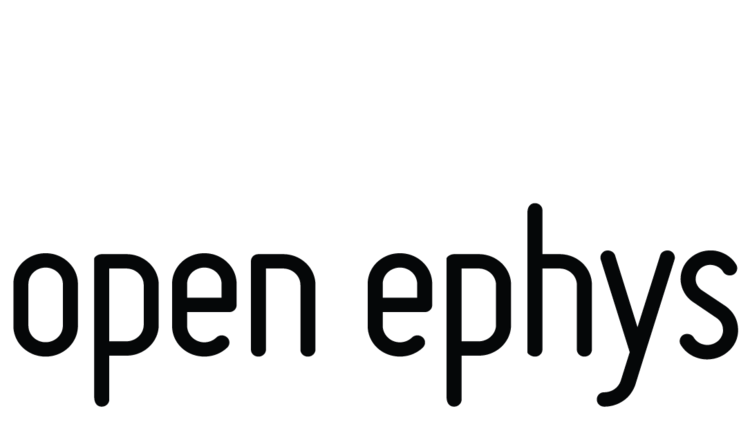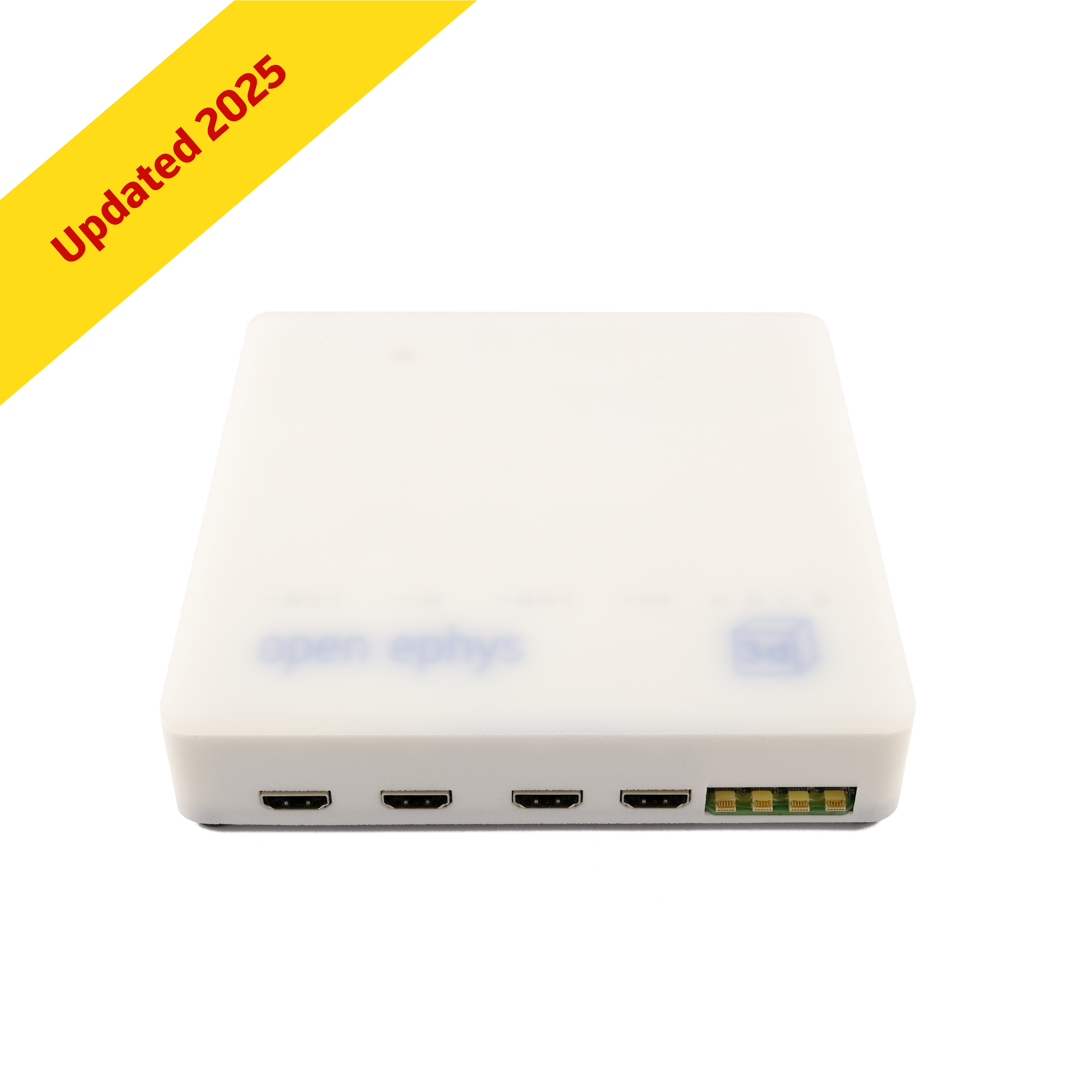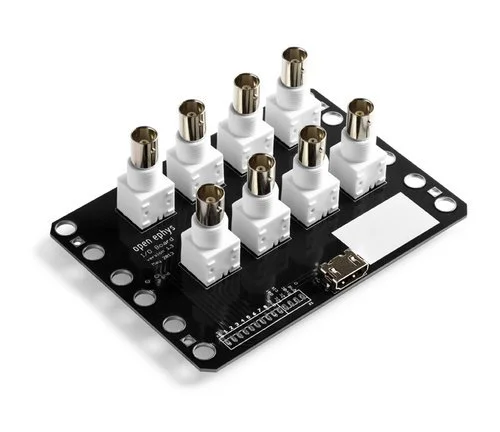Open Ephys Acquisition Board (3rd Generation)
Flexible and affordable multichannel electrophysiology
The 3rd Generation Acquisition Board is part of a complete platform for multichannel electrophysiology
that includes unique 3D capabilities to enable new types of experiments!
The 3rd generation of our Acquisition Board captures up to 512 ch of neural data and absolute head orientation from our 3D capable headstages to drive a torque-free commutator for tangle-free naturalistic recordings.
Key Features
Plug and play (Mac & Win & Linux)
Up to 512 channels of ephys using industry standard Intan amplifier chips
1–30 kHz Sampling Rate
Low Noise 2.4 µV rms
Electrophysiological input range: ± 5 mV
True real-time audio monitoring
NEW! 3D capable headstages acquire absolute head orientation data and drive our torque-free SPI commutator
NEW! Faster boot times and headstage recognition
Connectivity
Up to 8 RHD headstages on 4 tethers (up to two 64ch RHD chips per headstage port)
Standardized SPI digital headstage tethers
USB 3.0 data transmission
8 TTL inputs and 8 TTL outputs
8 analog inputs (± 5 V)
8 analog outputs (± 5 V)
Standardized I/O cables
NEW! Direct compatibility with the Harp family of devices
3D capable electrophysiology headstages
The Acquisition Board works with industry standard Intan RHD recording chips to interface with passive electrodes such as silicon probes, twisted wires and other microelectrode arrays. Researchers can opt for monopolar (multiple single-unit acquisition) or bipolar inputs (EMG or EEG acquisition) from our headstage range.
We now have 3D capable variants available for all of our headstages. These can be used to acquire absolute orientation data with the 3rd Generation Acquisition Board, as explained below. Of course, the 3rd Generation Acquisition Board still works with all previous RHD headstages from us or other vendors.
Double-click the video to enlarge.
Acquire absolute head orientation with our 3D capable headstages
Our 3D capable headstages accurately monitor absolute head orientation thanks to an embedded 9-axis inertial measurement unit (IMU). This technology senses rotational movements - pitch, yaw, and roll - providing real-time orientation data during freely moving animal behavior. When recording electrophysiology data alongside acquiring IMU data, researchers can correlate neural activity with specific behavioral events. Additionally, our 3D capable headstages can be used to drive our torque-free SPI commutator.
Vertical and low-profile headstage variants
With a compact height of 4 mm, our low-profile headstage significantly reduces torque on the animal's head in comparison with standard 20 mm tall vertical-profile headstages.
The low-profile headstage supports 64 channel implants with a Hirose connector, while weighing 0.92 g, making it ideal for use with our ShuttleDrive tetrode drive. The 32 channel vertical profile is an alternative for silicon probe Omnetics based implants, and weighs 1.25 g. We offer both profile variants with 9 degrees of freedom 3D capabilities or a 3-axis accelerometer.
Double-click the video to enlarge.
Upgraded board AND upgraded GUI
The Acquisition Board works seamlessly in the Open Ephys GUI, enabling real-time signal visualization, processing and recording. The GUI is free and open source. Its flexible plugin architecture lets you create a signal chain adapted to the specific needs of your experiments, with an easy to use drag and drop interface and ever growing collection of plugins. The long-awaited 1.0 GUI release provides first-class support for 3D capable headstages, performance improvements, and user interface enhancements. Read about the 1.0 release here.
Open Ephys FPGA module
The Acquisition Board uses an open-source FPGA (Field-Programmable Gate Array) module developed by the Open Ephys engineering team. Acting as the 'brain' of the acquisition board, the FPGA controls data acquisition, attaches a common timestamp, and efficiently sends data to the computer via USB. In doing so, it ensures synchronization across the setup. This technology is essential for capturing and responding to brain activity with minimal delay, making it a key component of our device ecosystem.
Our active torque-free SPI commutator provides a tangle-free connection between the 3rd Generation Acquisition Board and any of the 3D capable headstages on a freely-moving animal. The absolute orientation sensor on 3D capable headstages enables active commutation based on head orientation measurements instead of requiring tether to transmit force generated by the animal as needed by torque-based motorized commutators.
Standardized input/output connectivity
The Acquisition Board has 8 channels of digital in, 8 channels of digital out, 8 channels of ± 5 V analog input, and 8 channels of ± 5 V analog output. All this I/O uses the same standardized HDMI connectors. We provide an I/O board with 8 BNC connectors which you can use for any port, or you could even incorporate a HDMI connector into your custom equipment to connect it to the acquisition board directly without any bulky BNC cables.
All the devices connected to the acquisition board are sampled at the sample rate as the headstages, so you can easily synchronize external datastreams (e.g. behavioral cameras or stimulation devices) with neurophysiological recordings such as extracellular activity.
Example application: Stimulate optogenetically at specific phases of a theta oscillation.
Easy to use closed-loop feedback
When using the Open Ephys Acquisition Board, neural data is streamed to the GUI with an approximate delay of 10 ms. This latency is sufficient for most applications, enabling the detection of neural or behavioral states and allowing timely interventions, such as stimulus changes, optogenetic manipulation or any other closed-loop experiment-specific actions. If you’re interested in shorter latencies, check out our ONIX next-gen ecosystem.
The Open Ephys GUI can also stream data to other applications, such as Python or MATLAB, via its ZMQ interface, ensuring smooth integration for live signal processing, visualization, and data analysis.
Just started? Get training!
Learn how to work with our Acquisition Board alongside members of our team. This remote training is tailored to your scientific project and thoroughly covers all aspects of acquisition hardware. In-depth explanations of electrophysiology data acquisition and equipment details, operation of the Acquisition Board in the Open Ephys GUI, synchronization and triggering with external hardware and data structure and loading in Python or Matlab.
Consult our Training page for more detailed information.
Citing this Work
Citations are critical for tracking the impact of open source designs like this one. If you use this hardware, please cite the following papers in your work:
Acquisition Board and GUI
Siegle JH, Cuevas López A, Patel YA, Abramov K, Ohayon S, Voigts J (2017) Open Ephys: an open-source, plugin-based platform for multichannel electrophysiology. J Neural Eng 14: 045003 PDF
Torque-free Commutator
Newman JP, Zhang J, Cuevas-López A, Miller NJ, Honda T, van der Goes M-SH , Leighton AH, Carvalho F, Lopes G, Lakunina A, Siegle JH, Harnett MT, Wilson MA, Voigts J. (2024) ONIX: A unified open-source platform for multimodal neural recording and perturbation during naturalistic behavior. Nat. Meth. 22: 187–192 PDF
Are you interested in other published Open Ephys tools? Do you want to see how scientists around the world are using our hardware? Take a look at the work featured on our Publications page.














